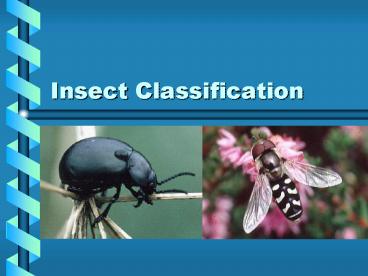Insect Classification - PowerPoint PPT Presentation
1 / 35
Title:
Insect Classification
Description:
Order Araneida ( spiders) Class Trilobita ( Ancient Trilobites) ... ( grasshoppers, katydids, crickets, camel crickets, walking sticks, praying mantids and roaches) ... – PowerPoint PPT presentation
Number of Views:7621
Avg rating:3.0/5.0
Title: Insect Classification
1
Insect Classification
2
Introduction
3
Insects are the most successful life form on the
planet.
- There are well over 1 million different known
species of insects in the world, and some experts
estimate that there might be as many as 10
million. - The largest is the Beetles (Coleoptera) with 125
different families and around 500,000 species. - One in every four animal species on this planet
is a beetle.
4
Insects are everywhere
- On land though there isn't anywhere you can go
that you can't find some insects living there,
even in the frozen extremes of Arctica and
Antartica you will some insects alive and active
during the warmer months.
5
Insects are Everywhere
- You will find that insects are ubiquitous, they
are in the soil beneath your feet, the air above
your head, on and in the bodies of
the plants and animals around you, as well as on
and in you.
6
The Biggest
- Acteon Beetle (Megasomaacteon) from South America
the males of which can be 9cms long by 5cms wide
by 4cms thick
7
The smallest
- There are an incredible number of very small
insects in the world, far more than there are
giants. Many beetles are less than one millimeter
in length, and the North American Feather-winged
Beetle Nanosella fungi at 0.25mm is a serious
contender for the title of smallest insect in the
world.
8
How they relate to our unit on classification
- http//www.earthlife.net/insects/six.html
9
Example of Insect Classification
- Kingdom Animalia
- Phylum Arthropoda
- Class Uniramia (Insecta)
- Order Lepidoptera
- Family Nymphalidae
- Genus Aglais
- Species urticae
- Common Name tortoise shell butterfly
10
Class Insecta
- Kingdom Animalia
- Phylum Arthropoda
- Class Uniramia (Insecta)
11
Related Non Insect Classes
- Class Arachnida
- Order Scopionida ( scorpions)
- Order Solpugida ( wind scorpions)
- Order Phalangida ( daddy long legs)
- Order Acarina ( mites)
- Order Araneida ( spiders)
- Class Trilobita ( Ancient Trilobites)
- Class Crustacea ( shrimp, crayfish, crabs, rolly
polly potatoe bugs) - Class Diplopoda ( millipedes)
- Class Chilopoda ( centipedes)
12
Class Insecta ( Insects)
- The class insecta can be broken down into over 27
different order groups of classification
13
The Eight most common orders are..
14
Odonata ( dragon flies and damselflies)
- 5300 species worldwide
- Aggressive Carnivores
- 30,000 lenses per eye. You have only one per eye.
Who has the best eyesight?
15
(No Transcript)
16
Orhoptera ( grasshoppers, katydids, crickets,
camel crickets, walking sticks, praying mantids
and roaches)
- 20,000 species
- Some can sing
- Some are often harmful to crops
17
(No Transcript)
18
Dermaptera (Earwigs)
- 1200 species
- Unique because they take care of their young.
19
(No Transcript)
20
(No Transcript)
21
Coleoptera (Beetles)
- 370,000 different known species
- 1 out of every 4 or 25 of all animals is a
beetle. - They are perhaps the most successful life form on
the planet earth. - They always have a straight line down the back to
distinquish them as beetles.
22
(No Transcript)
23
(No Transcript)
24
(No Transcript)
25
Lepidoptera (Butterflies and moths)
- 150,000 species
- Have a part of their mouth that is used to suck
up food. - Favored by many
- Feed on yucky stuff
26
(No Transcript)
27
(No Transcript)
28
(No Transcript)
29
(No Transcript)
30
(No Transcript)
31
(No Transcript)
32
(No Transcript)
33
Diptera (Flies and Mosquitoes etc.)
- 100,000 Species
- One set of wings
- One of the most successful insects aside from
beetles - Some eat some dont
- Have Mr. Hutchinson read the fly story to you.
34
Hymenoptera (Bees, Wasps, Ants etc.)
- 120,000 Species
- Some scientists think there may
- Be as many as 300,000 species that have not been
named yet.
35
(No Transcript)































